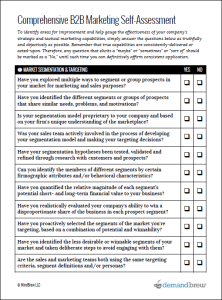The start of the year is always a good time to take stock of how things are going and what needs to be improved. It’s a natural opportunity to take a break from the day-to-day grind, step back for a moment, and look at your efforts from a different perspective.
When we talk with B2B marketing groups about how they stack up to the marketing teams at leading firms, we encourage them to examine their efforts in ten different areas:
- Market Segmentation and Targeting—Have you explored multiple ways to segment or group prospects in your market for marketing and sales purposes? Can you identify the members of different segments by certain firmographic attributes and/or behavioral characteristics? Have you quantified the relative magnitude of each segment’s potential short- and long-term financial value to your business?
- Marketing Research and Competitive Analysis—On a regular basis, do you conduct in-depth interviews with a number of customers and prospects in each of your target segments? Have you gone on sales calls with your sales team to gain a better understanding of what actually happens in the field? Do you make sales and marketing decisions based on your research rather than internal assumptions, gut feelings, or what’s popular?
- Product Offerings and Pricing Structures—Are your offerings innovative and/or distinctive in ways that align to prospects’ top priorities, value drivers, and selection criteria? Do your product lines or offerings contain “good, better, best” options to leverage choice dynamics and promote price/value tradeoffs? Are strategic and tactical pricing considerations an integral part of your product development process, rather than an afterthought?
- Go-To-Market and Channel Management—Do you regularly reassess your routes to market as your business evolves and the competitive environment changes? Are your go-to-market decisions based on what’s really best for your marketing strategy, rather than following “industry standards”? Are your go-to-market decisions based on what’s really best for your marketing strategy, rather than following “industry standards”?
- Strategy Articulation and Differentiation—Have you documented a comprehensive “master story” or “stadium pitch” for each of the segments that you are targeting? Do you provide credible proof and evidence that your sales and marketing claims are accurate and not just puffery? Are your messages focused on what prospects already believe to be important, rather than what you think they should care about?
- Demand Generation and Cultivation—Have you assessed the nature of your market (defined vs. undefined) and designed your demand generation programs accordingly? Rather than engaging in generic “branding” exercises, do your demand generation activities all have specific, measurable objectives?
- Sales Effectiveness and Enablement—Do you provide salespeople with competitive “kill sheets” for each targeted combination of customer segment and product? Are your sales and marketing groups in alignment around which segments will be targeted and which segments will be avoided?
- Customer Remarketing and Retention—Do you have ongoing remarketing programs, specifically designed to engage, retain, and grow your existing customers? Are you monitoring and analyzing your customers’ buying patterns to anticipate upcoming sales or replenishment opportunities?
- Performance Measurement and Optimization—Does your marketing function have a “by the numbers” orientation, where financial performance is the primary consideration? Are you measuring the conversion ratios and durations between all of the major stages of your overall marketing and sales process?
- Team Development and Alignment—Do you have ongoing training programs and educational resources that are specific to marketing in B2B environments (vs. B2C)? Have your marketing people been trained to understand the critical differences between strategic and tactical marketing?
As you consider these ten areas, pay special attention to the first five, which are really critical for your overall strategy. However, a deficit in any of these ten areas would give you a good starting point for your New Years’ marketing resolutions.
If you’d like to be more systematic about your evaluation of your team’s efforts, check out the DemandBrew Comprehensive B2B Marketing Self-Assessment. This 10-page report card includes 134 different questions that can help you identify room for improvement in the new year.







